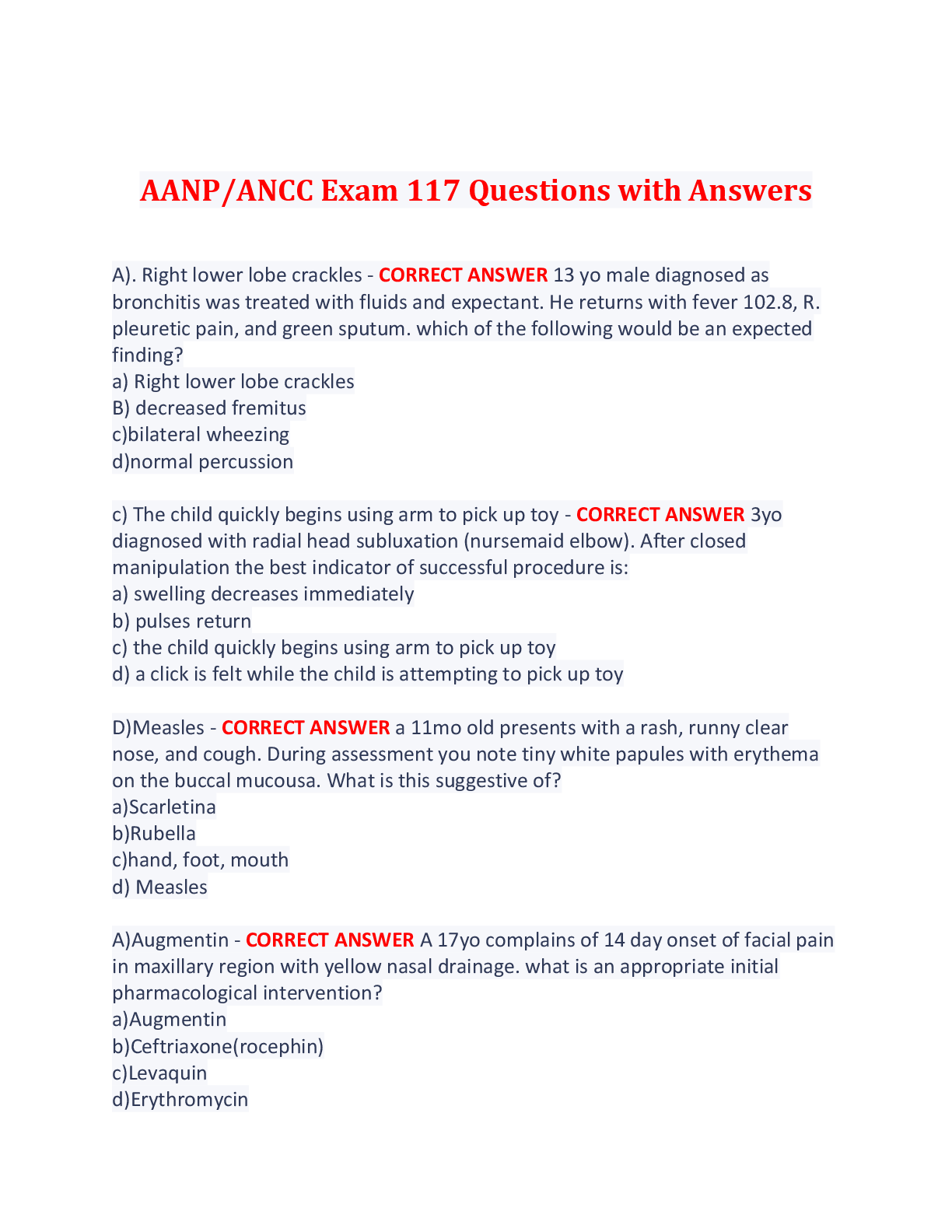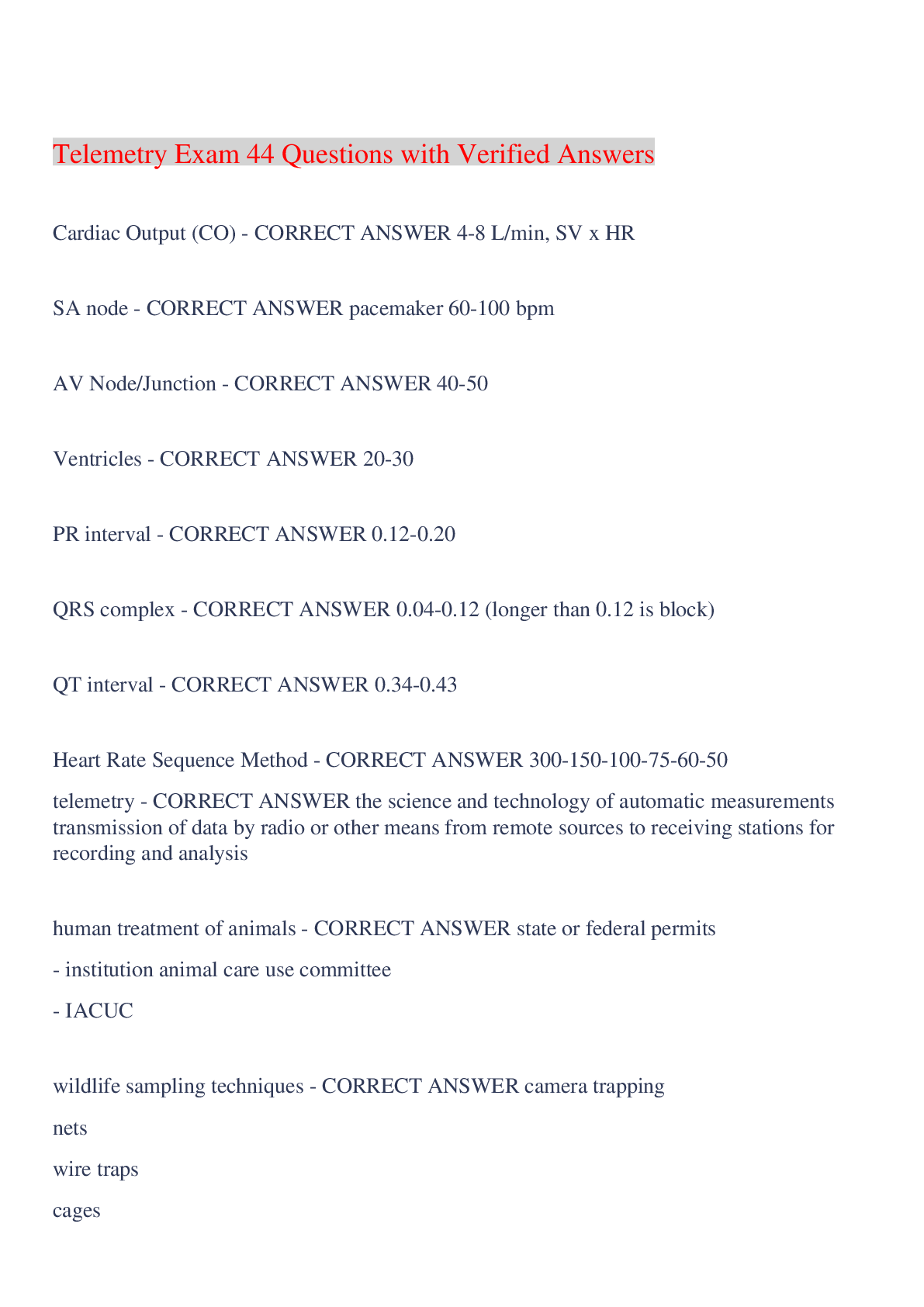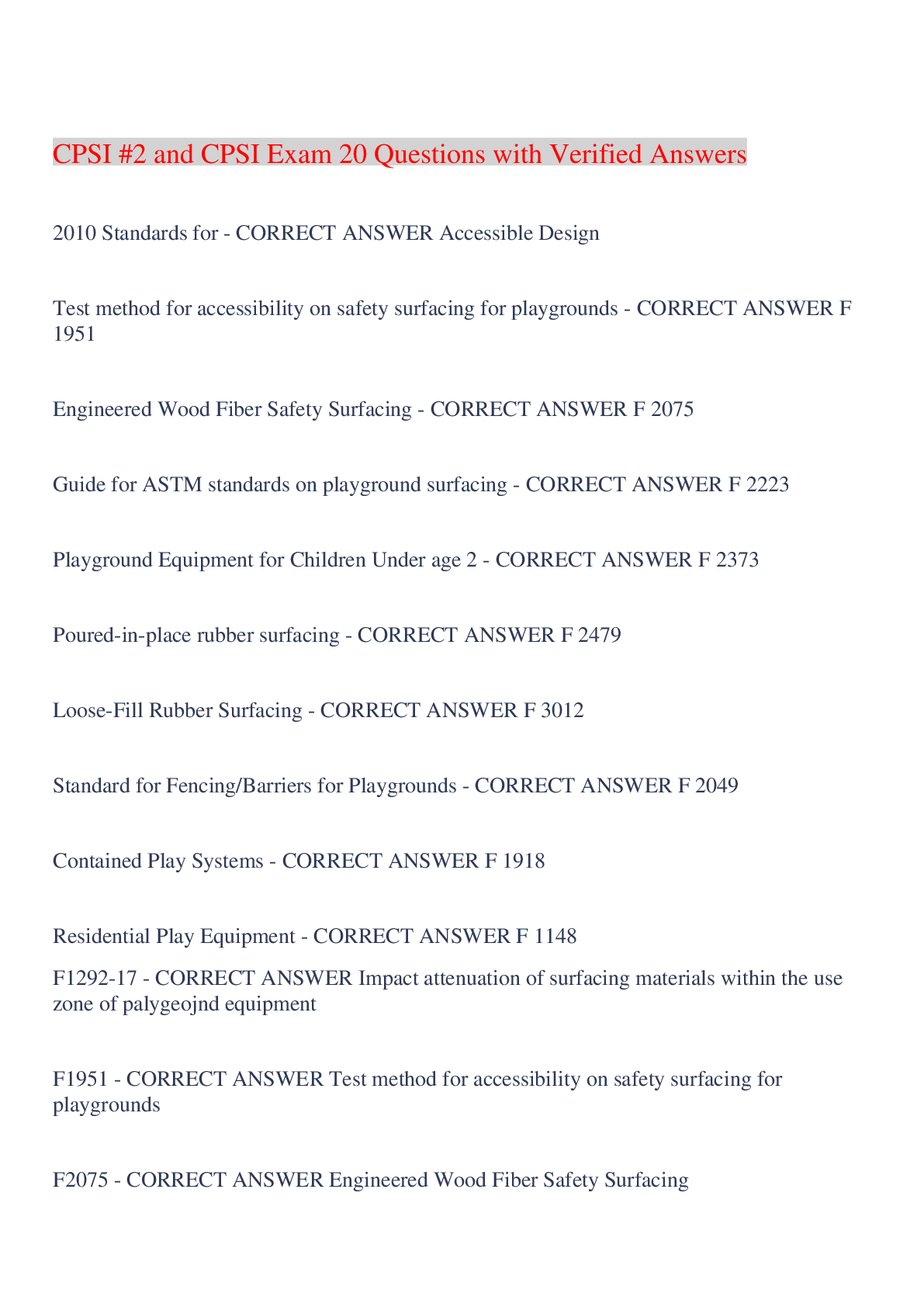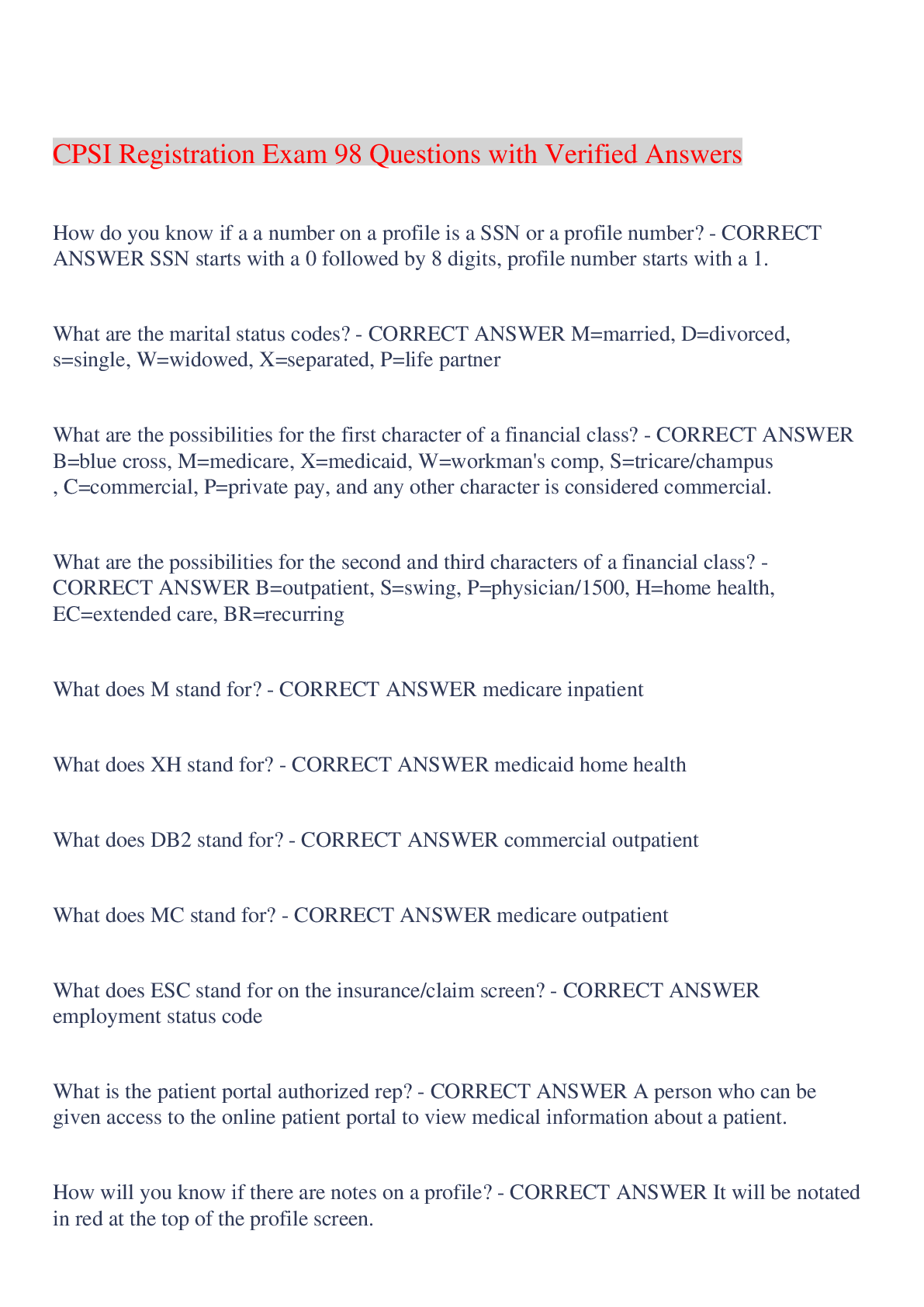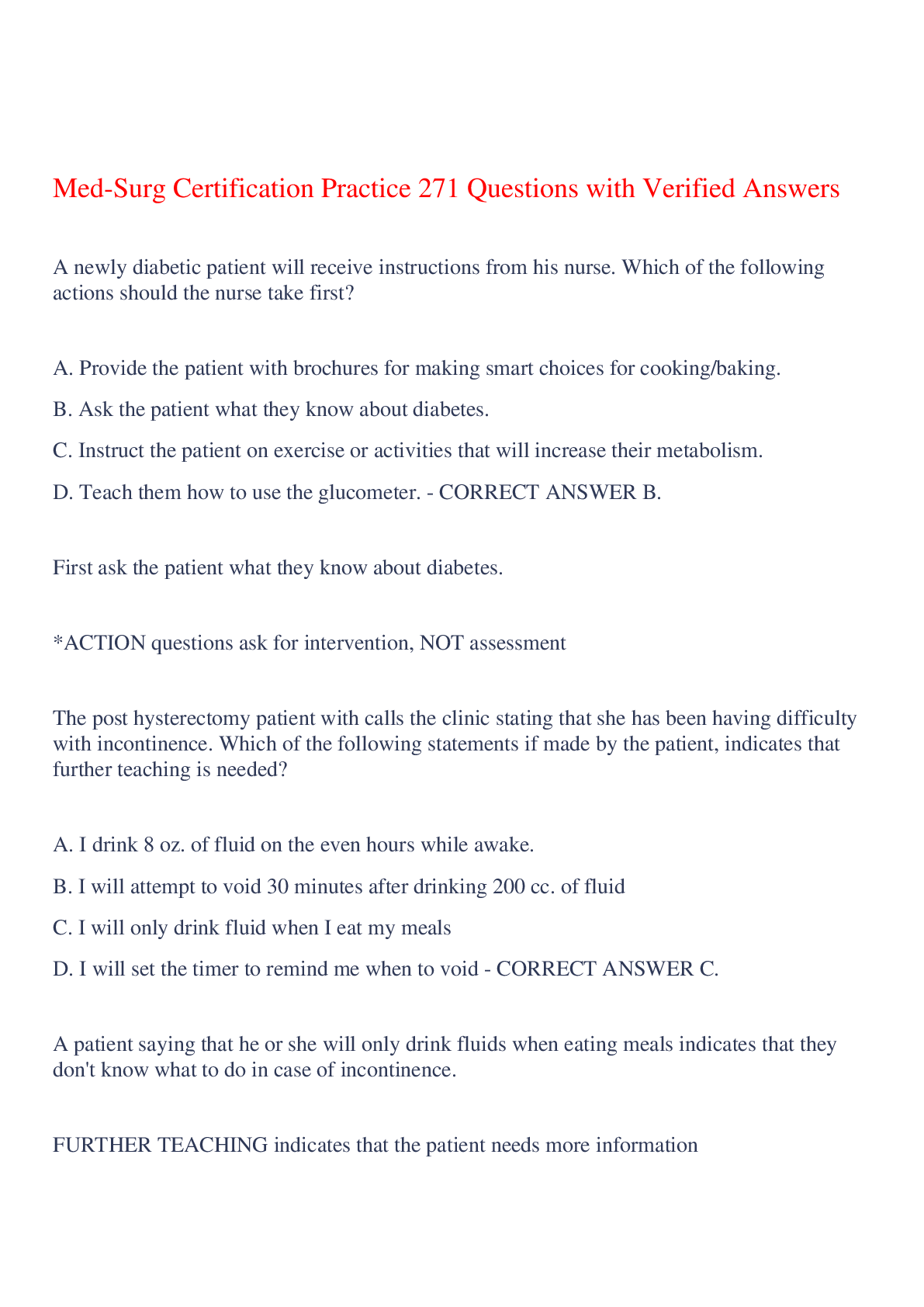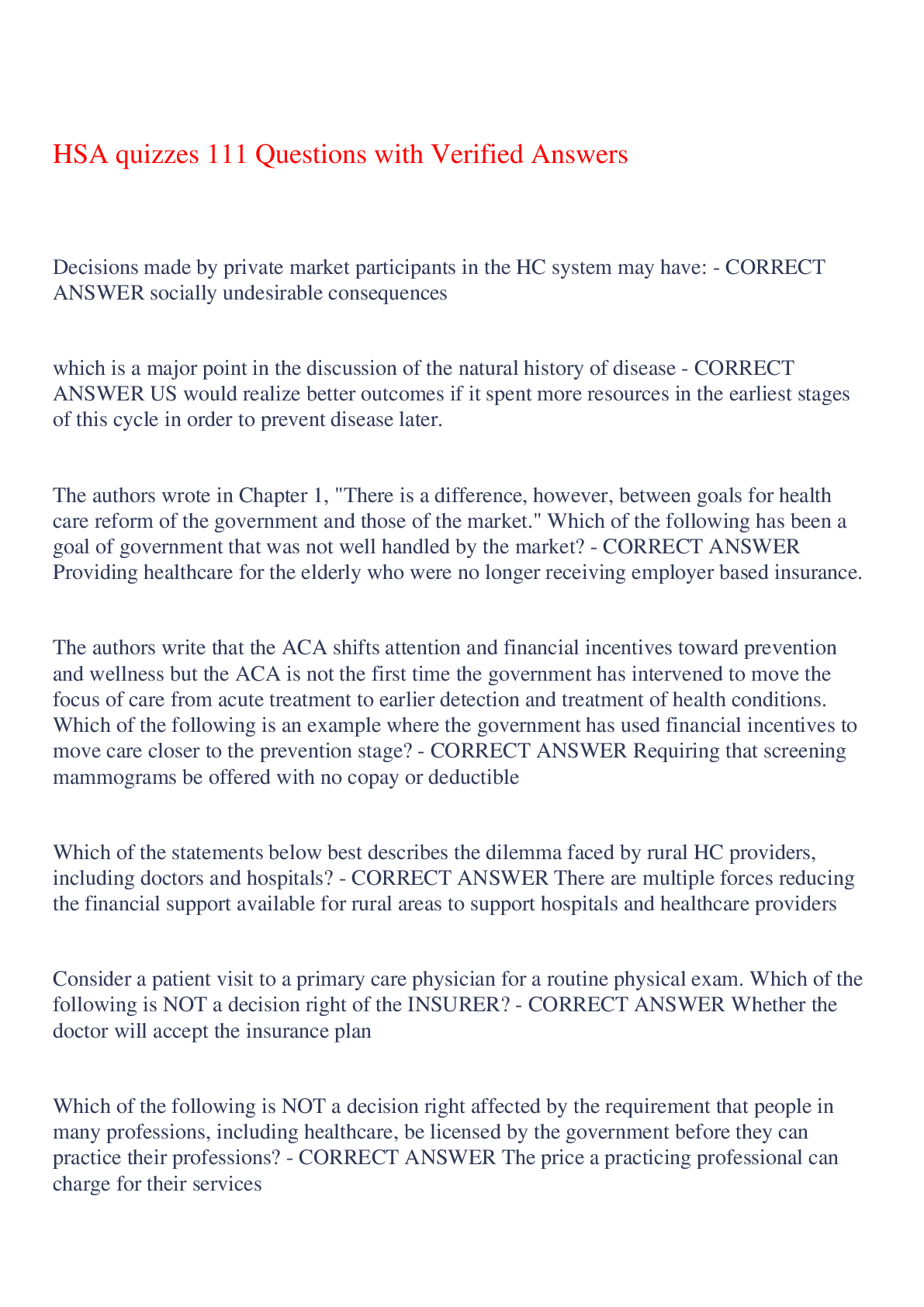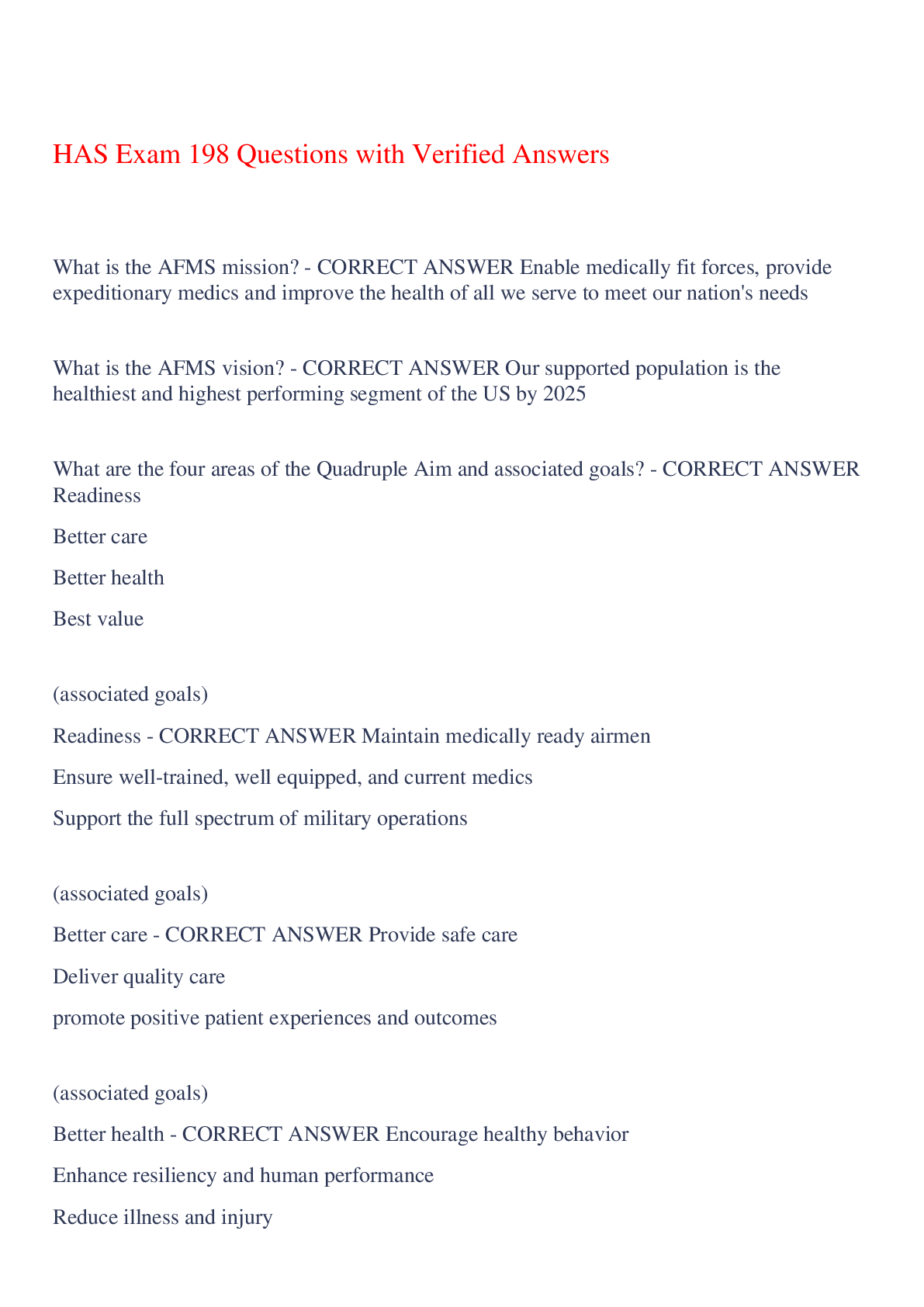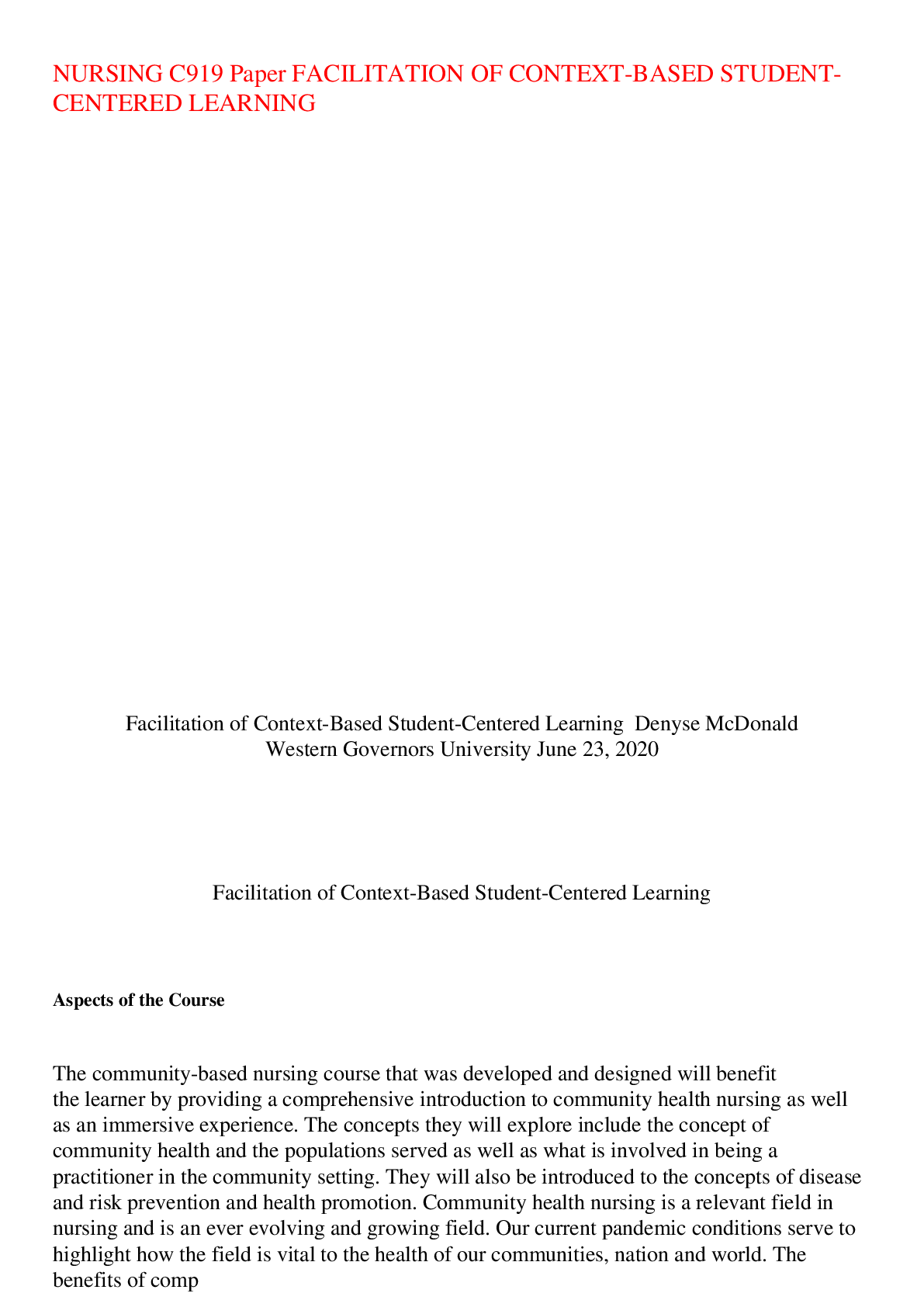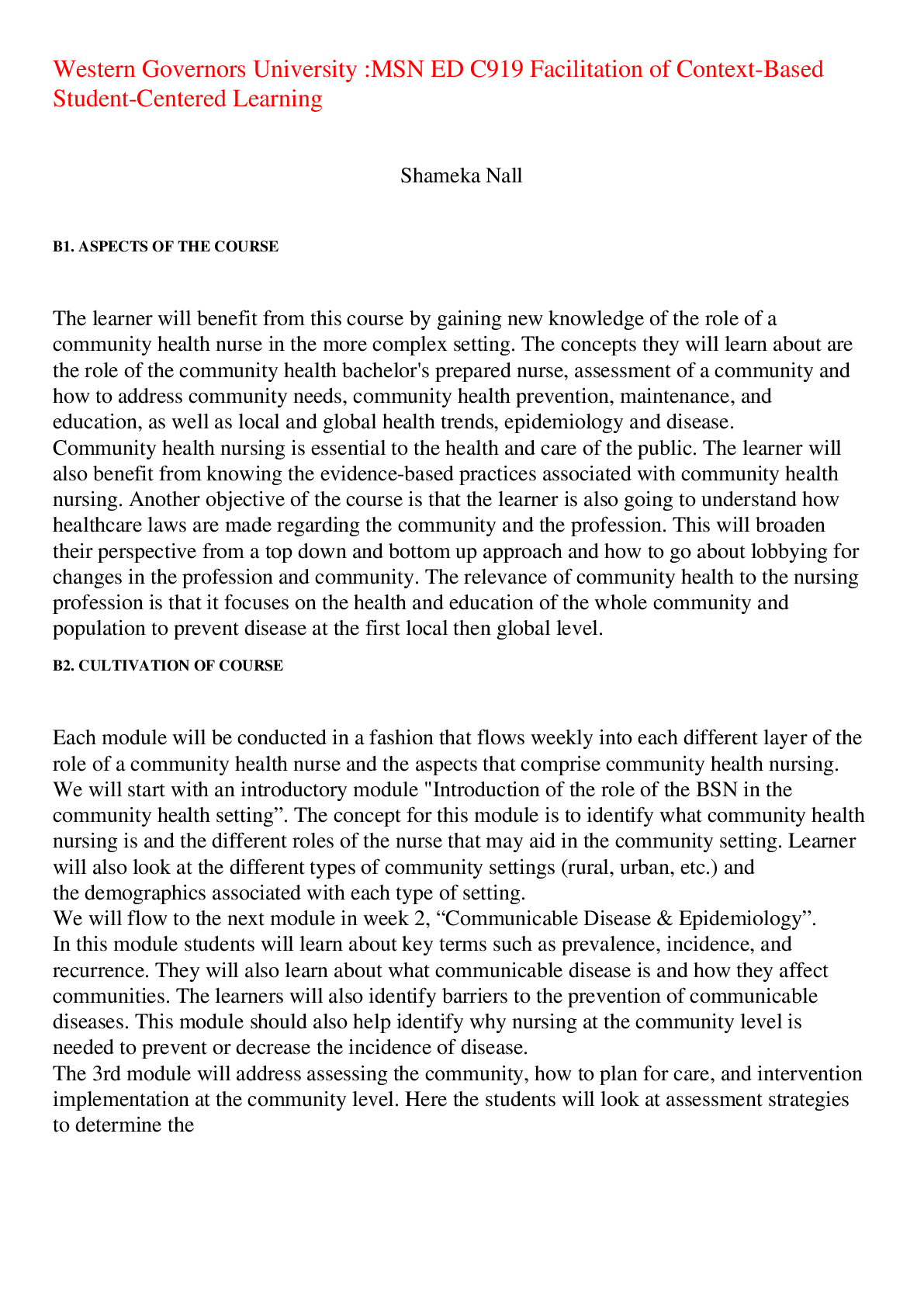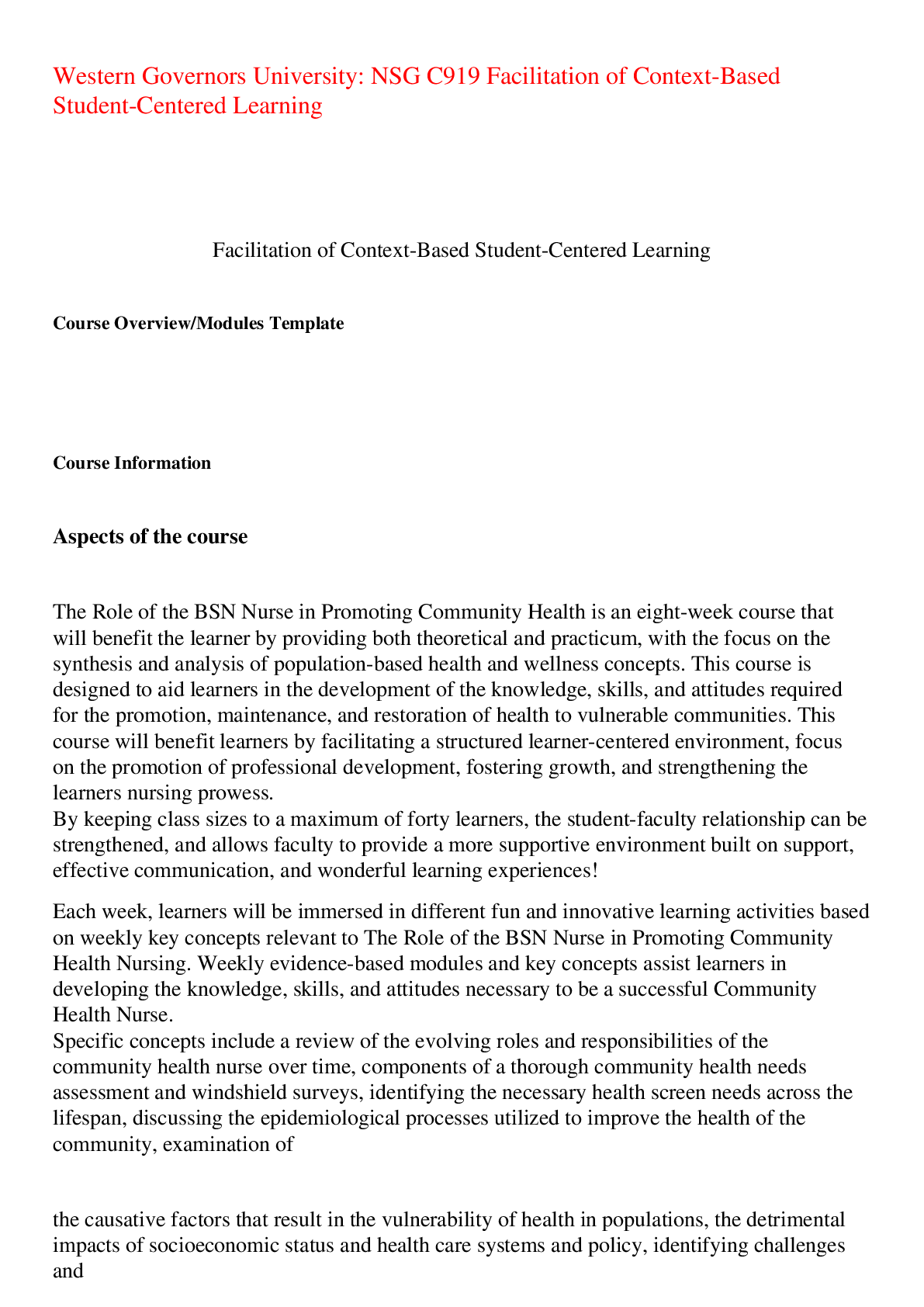*NURSING > EXAM > NURSING C919 Paper FACILITATION OF CONTEXT-BASED STUDENT-CENTERED LEARNING,100% CORRECT (All)
NURSING C919 Paper FACILITATION OF CONTEXT-BASED STUDENT-CENTERED LEARNING,100% CORRECT
Document Content and Description Below
NURSING C919 Paper FACILITATION OF CONTEXT-BASED STUDENT-CENTERED LEARNING Facilitation of Context-Based Student-Centered Learning Denyse McDonald Western Gove... rnors University June 23, 2020 Facilitation of Context-Based Student-Centered Learning Aspects of the Course The community-based nursing course that was developed and designed will benefit the learner by providing a comprehensive introduction to community health nursing as well as an immersive experience. The concepts they will explore include the concept of community health and the populations served as well as what is involved in being a practitioner in the community setting. They will also be introduced to the concepts of disease and risk prevention and health promotion. Community health nursing is a relevant field in nursing and is an ever evolving and growing field. Our current pandemic conditions serve to highlight how the field is vital to the health of our communities, nation and world. The benefits of completing this course is developing a generalist’s familiarity of community nursing preparing them for entry into the field. Cultivation of Course The course begins with an introduction to community health nursing and the populations served. The next module builds upon the introduction by then exploring the community as a patient and assessing and diagnosing the needs of the community. Then students will examine the roles and function of public health nurses. The next module will then move into one of the roles of community nursing and visit epidemiology at the community level, the following module will then utilize the epidemiological applications along with the surveillance and outbreak investigation to complete an escape room by stopping a simulated outbreak in their community. The next module will then explore evidence-based practice and highlight it’s importance in all fields of nursing. Then the students will utilize that knowledge to learn about health promotion and the best ways to disseminate information at the community level, and finally they will combine the knowledge of health promotion to the idea of risk reduction. Each module builds upon and uses the information learned in the previous module to grow the knowledge and cultivate a deeper learning of the material. Student-Centered Learning While planning the course student-centered learning was the goal. Student-centered learning shifts the learning experience from the “sage of the stage” to more active learning with the instructor facilitating; the focus is on clinical reasoning and judgement as well as critical thinking (Billings & Halstead, 2017). The students are all diverse individuals and student- centered learning uses that diversity to expose classmates to diverse possibilities and prepares them for inter and intra-professional relationships. There is a shift of learning content before class versus being passively fed data “by the sage on the stage” is the first step in this shift. The students are responsible for their own work outside of class, which includes reading and listening/watching to any assigned content. This places the instructor as a facilitator to learning. When students show up to class they should already have a basic understanding of each weekly key concept, then during class we will dive deeper and help foster a deeper understanding of the material, by utilizing active learning techniques and changing modalities (Wise, 2017). The active learning will cover different learning styles to meet the students where they are and hopefully reach all types of learners be they visual, tactile, aural or combinations of each. Module one covers the introduction to the course. Students will do the assigned reading and watch an online lecture burst before showing up to class. During class we will have a group discussion, which will encourage diverse discussion of ideas and personal experiences. This will be a good introduction to the course and the students to each other. This will be the foundation of their collaboration, which is key to student-centered learning. Module two covers Community Assessment and Evaluation. Students will complete all assigned pre-work and then within small groups, of no more than four, they will go out into the community to complete a windshield survey. They will use online public health resources, visual observations and interviews to complete not only the survey but a community assessment based upon their windshield survey. This is student-centered learning because it will involve multiple modalities of information gathering and require group work and then presentation of findings with class discussion. Module three covers Nursing Practice at the Local, State and National Levels in Public Health. The students will be required to complete the pre-work and reading prior to class. They will be paired up and given a problem-based scenario to roleplay for the class. This is student-centered learning due to the focus on problem-based scenarios and the group and critical thinking involved in order to role-play the scenario. These scenarios will encompass “problems” at each level of public health and how the nurse should react/act. Module four covers Epidemiological Applications. This module requires a bit of pre- work and research on the parts of the students and their respective groups. They will be assigned a disease or problem and a community (prison, small town, city, school etc.). Within their group they will have to make a power point presentation of their “problem” using the principles of epidemiology. They will need to cover transmission, tracking, impact and role of the community nurse in each situation, followed by questions from their peers. The instructor will help moderate and debrief students. This is student-centered, because it is problem focused and encourages critical thinking and helps improve clinical judgement. It once again prepares the student for the role of community health nurse. Module five builds upon Module four and covers Surveillance and Outbreak Investigation. The required reading and pre-work as well as the previous week’s work will all come in handy when they compete to complete an Outbreak Escape Room. The class will be divided into four teams (with winning team getting bragging rights and a small reward). They will take turns competing to see who can escape from the Outbreak the fastest with the most survivors. They will be allowed to use, notes, books and online resources, to complete each portion of the game. Allowing for collaboration, and multiple modalities of information gather is how the learning is student-centered. Module six focuses on Evidence-Based Practice (EVP). The students will complete research of EVP in the community setting and conduct and interview. They will write a scholarly paper about the EVP and what they learned and then reflect upon the importance of EVP to community nursing. This module is student centered because it allows the students who are maybe not so group and socially oriented/driven to shine individually as well as explore EVP in practice in their community. The reflection portion is important for growth and retention of the knowledge they gain. These papers will be posted in an online “forum” setting so that students may read each other’s postings and comment and gain further understanding. The instructor will moderate. Module seven focuses on Health Promotion. The students will again be placed into groups of four for a poster presentation to their peers, faculty, other science related degree programs, community health practitioners and the public. They will as a group discuss and choose a public health “problem or concern” for their community, and then complete a poster presentation. The health promotion presentation will be evaluated by those in attendance as well as the presenters with grading being a combination of input from those sources. This places the students in the role of “patient” educator, and is important for students to gain experience and confidence with the role. Module eight focuses on Risk Reduction. For this module students will be paired up to complete an evolving case study. The case studies will cover all aspects of Community Health Nursing and the students will have to rely on what they have learned to this point to successfully complete the case study with the best outcomes. Minimal resources will be allowed for this case study and will be provided by the instructor. Students may collaborate with other groups and have one lifeline/phone a friend with the instructor for help. This problem-based scenario is student-centered because it is problem based and requires clinical judgement and critical thinking to complete. The instructor is a facilitator to the learning. Each of these modules is student-centered by definition and cultivate and expand upon the student’s clinical judgement and critical thinking skills. This is essential for success as a student and as a nurse. Professional Standards and Guidelines While developing the course outline it was imperative that each weekly key concept align with the professional guidelines, this instructor chose to utilize the guidelines set forth by the American Association of Colleges for Nursing (AACN). Week one is our introduction which introduces population focused care and delivery and week two delves further into assessing the population as a patient. These align with Essential VII, which focuses on population health and clinical prevention (AACN, 2008). In week three, Nursing Practice at the Local, State and National Levels in Public Health we examine the roles and functions of a public health nurse which aligns with Essential VIII regarding professional values and professionalism as well as Essential V, which deals incorporates policy, finance and regulatory bodies (AACN, 2008). Weeks four, five, seven and eight all directly align with Essential VII which again focuses on population health and clinical prevention (AACN, 2008). Finally week six focuses on evidence- based practice, which directly aligns with Essential III and incorporating evidence-based practice in the clinical setting (AACN, 2008). All of the components of the class align with Essential IX, by introducing and giving the students a generalist nurse understanding of community health (AACN, 2008). Alignment of Weekly Key Concepts to Overview The course overview states that “This course introduces the concept of community health. We will explore population focused care, with a focus on health promotion, risk reduction and disease management from the community health perspective. We will examine the role of a community health nurse and the evolution of community-based care.” Weeks one and two are the introduction to the concept of community health and population focused care, which align with the first portion of the course overview. Weeks three and six deal with the role of community health nurse and the evolution of care, including evidence-based practice. Weeks four, five, seven and eight then focus on health promotion, risk reduction and community health, which cover the remainder of the course overview. Course Outline Relevance Creating a course outline is imperative to the development of a course. It is truly the framework that the rest of the course development is based. Lesson plans, activities, lectures etc, are all built from the outline. It is also easier to see how everything aligns with the programs chosen professional standards. It shows the basic learning environment being created by the instructor, including multiple methods and domains of teaching (Oermann, De Gagne & Phillips, 2018). The relevance of creating and outline is relevant to the role of a nurse educator because it is an important part of the course design process. It is the predesign roadmap, in that it helps outline requirements, objectives and accreditation needs prior to drawing up lesson plans (Billings & Halstead, 2017). It is easy to see any holes or any possible overlap before further course design and competencies are created/discussed. Course development is a key role of a nurse educator. Learning Strategies Utilizing a variety of active learning strategies is a great way to facilitate student learning and address the diversity within the learners. One of the learning strategies applied to the community health course was group discussion. Having an instructor facilitated group discussion can lead to deeper understanding of the materials presented and offer differing perspectives, causing students to think more critically. It moves them from the understanding/remembering domain into the application, analyzing and creating domain. Group discussion can challenge students to think outside of the box and see others’ viewpoints. Students come from many diverse backgrounds, age, ethnicity, culture and socioeconomic status, and by allowing all of those different backgrounds to have a voice, a deeper understanding of those differences can be learned and hopefully appreciated. It also helps prepare students for interprofessional collaboration (Bastable, 2019). Another learning strategy utilized in the course is gaming. Gaming appeals to the competitive nature and creates a dynamic and experiential learning environment for students (Bastable, 2019). This will address the learning needs of the younger tech savvy gaming generation as well as those who are competitive in nature. Again, students must use the deeper thinking domains and apply and analyze problem-based scenarios. This is what fosters better critical thinkers. The third strategy incorporated in the course is use of role play. This type of learning is affective and allows the learners to understand not only their role, but the roles others play as well. This can be combined with a role-played simulated environment to give the learners more psychomotor skills as well. This strategy addresses the needs of those hands-on learners and allows them to practice in a safe setting (Bastable, 2018). Implementation of Learning Strategies In order to address the diverse learning needs of students the gaming strategy will be developed to include all of the VARK learning types, visual, auditory, read/write and kinesthetic (Bastable, 2018). The game planned will be a live action outbreak scenario, which will be planned like a table top escape room. The students will be divided into groups based on their VARK assessments, one student from each classification. The clues given in the game will be a variety of formats with some video clues, some aural clues and reading and writing and interpretation and finally a kinesthetic problem. All students should be involved in each portion of the scenario and encouraged to work within the others strengths. Cooperative and collaborative learning will be achieved and it will address not only different learning styles but also different learning motivations. Assessment of Learning Needs and Styles While the activity addresses all of the VARK learning types the predominant learning style addressed however would be the visual variety followed closely by the read write (Bastable, 2018). Students will need to watch videos observe patterns as well as read the directions and questions. They will need to access websites and data banks and watch videos on the CDC site in order to complete the activity. Clinical Reasoning and Self-Reflection Skills The learning strategy will address clinical reasoning by making students follow the correct steps and actions to arrive at the predetermined outcome. In order to succeed at the game the students must not only have the knowledge of epidemiology and surveillance, they will need to correctly apply that knowledge in order to “win” the game. Working as a team then will need to reason through the problem-based scenario and use sound clinical reasoning to move on to each new step in the game. The self-reflection portion will occur at the completion of the game, when the instructor debriefs them. Questions like: “do you feel like you were successful in completing the activity?”, “what would you do differently?” “what did you learn from the activity that you didn’t know before?”, will spur the students to reflect upon the experience and further cement the deeper learning. I like to tell my students that the first step of assessment is self-assessment, so how did they feel like they did personally and as a team member, what did they do that was good and how can they improve from the experience? Learning Environments Teaching and learning occurs in many different environments, and it is important, as a nurse educator, to promote interprofessional collaboration and teamwork. In a face-to-face setting, collaboration via group discussions and small teamwork and projects would be ideal. Making sure to rotate groups and randomly select participants in the groups will encourage the students to develop better professional skills dealing with new team members they may not pick themselves. This is an important aspect of team/group work, because not always will you work with people who think and talk like you, it is important to experience the diversity in preparation for the workforce and interprofessional collaboration. Once students become accustomed to working in a team setting then it becomes important to start adding members of the team. Including students from other programs (medicine, occupational and physical therapy, respiratory, etc.) in the form of a collaborative group project would foster that learning and understanding of the other professional roles and promote growth in interprofessional collaboration and respect (Billings & Halstead, 2016). The same type of scenario could be carried out in the online setting as well. Using message boards to have teams work through evolving case studies and to discuss and plan care for complex patients. There could be video conferencing and group projects done completely in an online format. The students need to learn that they can work together to improve patient outcomes and learn the roles each plays so that they may practice collaboratively in the field. In the clinical setting this may be accomplished by having a collaborative simulation with other practitioners, or by allowing students to shadow practicing professionals to observe how they interact with their peers and reflect upon what they witness and what they would like to carry into their own practice. Regardless of the environment it is vital that new nurses are able to communicate effectively and work collaboratively with their peers in order to provide the best care possible to their patients. Nursing Students’ Experiences Nursing students are an immensely diverse population and that diversity can and does have a direct impact on their ability to learn. It is important as an instructor to view each student as an individual and not stereotype them based upon their gender, culture, socioeconomic status etc. (Bastable, 2018). If the socioeconomic status of students is examined as an impetus to learning, things like having to work full-time, not being able to afford nutritious foods or healthcare can all impact the students’ ability to learn. Cultural impacts may be based on religious or spiritual practices. There may be language barriers or social norms that prevent students from understanding context. Gender is also an issue. There have been many studies done regarding the human brain and the differences between the male and female brain and how they learn and express knowledge (Bastable, 2018). Finally, life experiences can also have an impact on learning. Students who have held other roles may not be able to transition as easily into the role of nurse. Watching students who have been CNAs for many years transition into nursing students has been an eye opener. It is easy for them to fall into the role of a CNA in the clinical setting,and must often be pushed to “think like a nurse”. Learning Theories While developing a nursing education course the learners must be considered as well as learning theories. While many theories exist the constructivist theory can apply easily to adult learners and nursing education. Bruner’s Constructivism theory states “learning is constructed by the learner; learners build upon existing knowledge through personal interpretation of experience. Past learning is connected to new learning (Billings & Halstead, 2016)”. Since nursing students are adult learners and come to the classroom with a diverse range of skills, abilities and experiences, the constructivist theory takes that into account and uses that foundation to help learner build their knowledge. In the flipped classroom it is important that the learners come to class prepared to apply the materials learned and as students progress through the program they continue to build upon nursing basics until they are dealing with higher level care. Learners must participate and apply knowledge to continue learning. Like any building an education needs a strong foundation to build upon, so nursing students start out with very basic skills and lessons and then gradually build upon those skills and knowledge. When they start they want to learn how to put in an IV, by the time they are done they should be able to explain why their patient needs an IV. We move from [Show More]
Last updated: 2 years ago
Preview 1 out of 8 pages
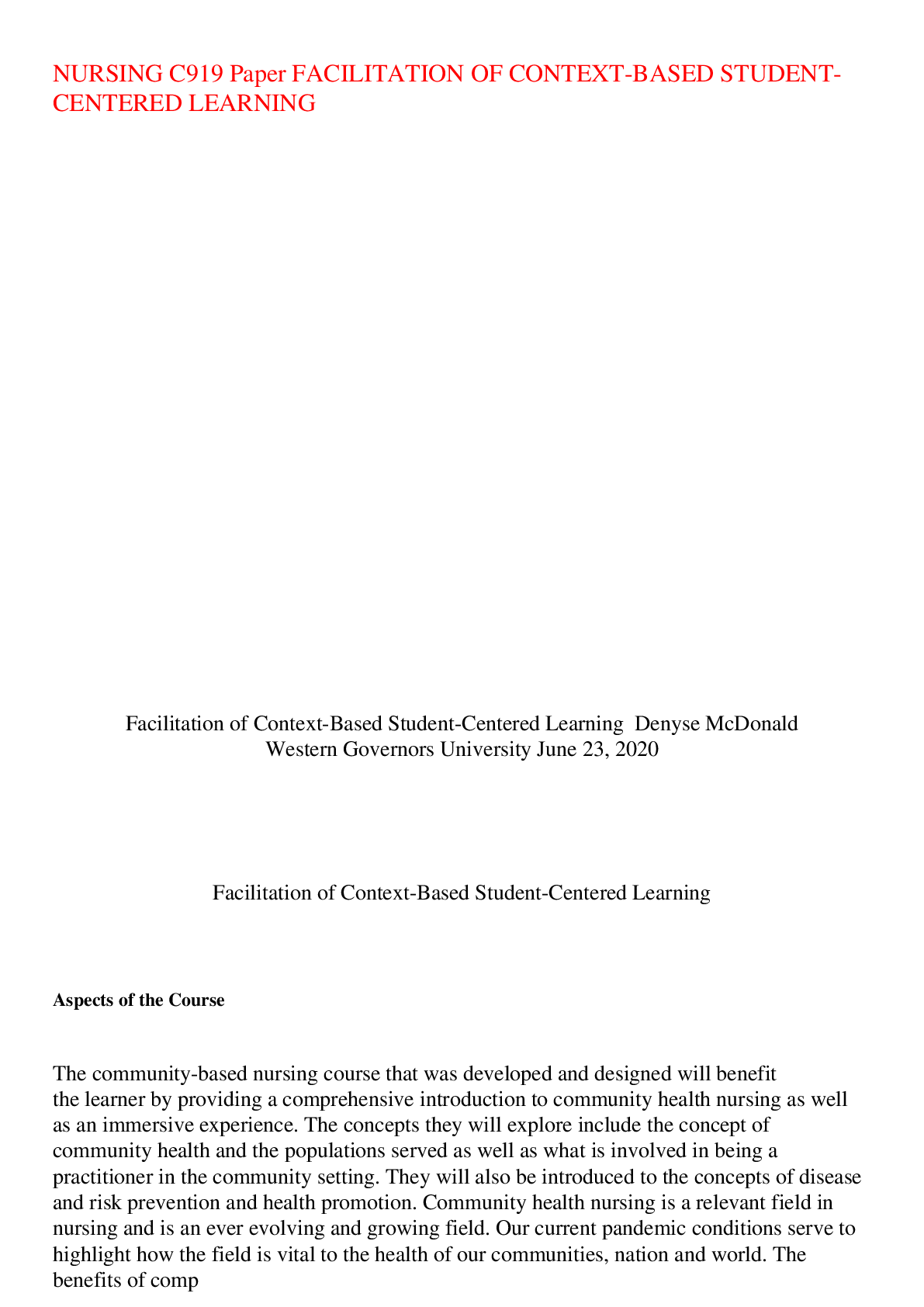
Buy this document to get the full access instantly
Instant Download Access after purchase
Buy NowInstant download
We Accept:

Reviews( 0 )
$12.00
Can't find what you want? Try our AI powered Search
Document information
Connected school, study & course
About the document
Uploaded On
Apr 02, 2023
Number of pages
8
Written in
Additional information
This document has been written for:
Uploaded
Apr 02, 2023
Downloads
0
Views
63


